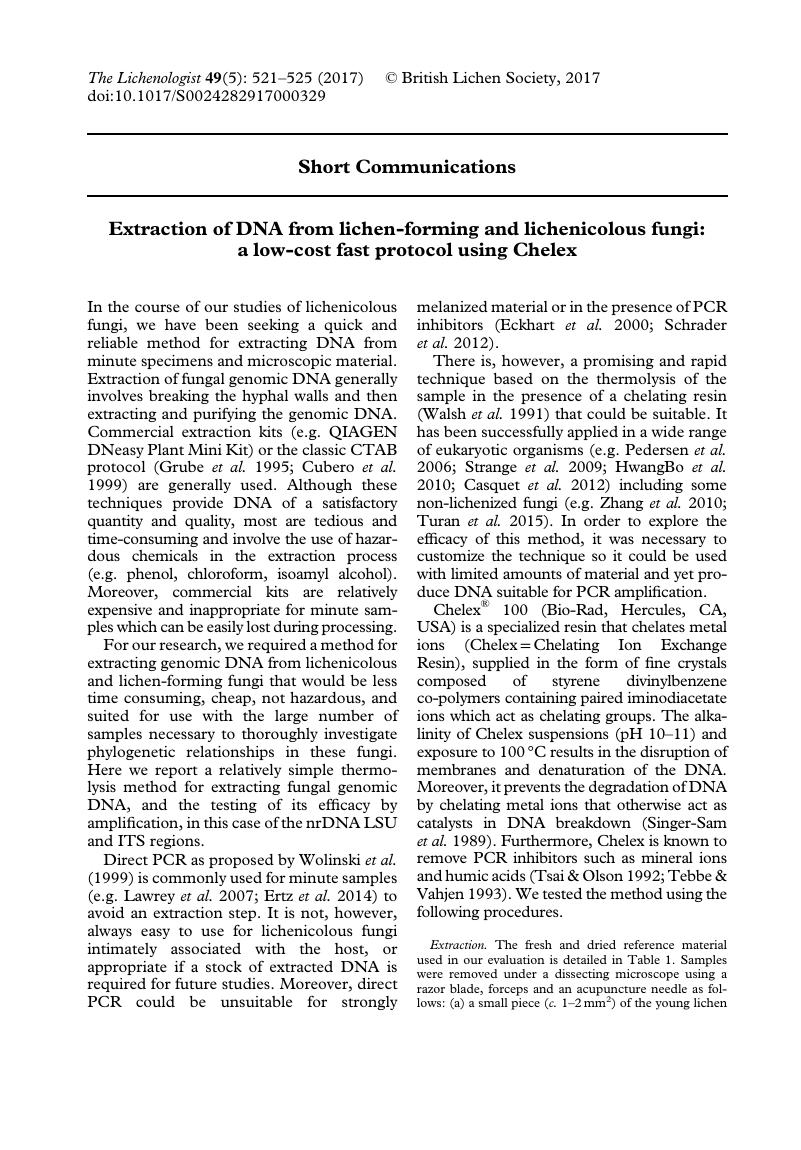Crossref Citations
This article has been cited by the following publications. This list is generated based on data provided by Crossref.
Lendemer, James C.
2018.
Recent literature on lichens—250.
The Bryologist,
Vol. 121,
Issue. 3,
p.
447.
Černajová, Ivana
and
Škaloud, Pavel
2019.
The first survey of Cystobasidiomycete yeasts in the lichen genus Cladonia; with the description of Lichenozyma pisutiana gen. nov., sp. nov..
Fungal Biology,
Vol. 123,
Issue. 9,
p.
625.
Arenas, Francisco
Navarro‐Ródenas, Alfonso
Marqués‐Gálvez, José Eduardo
Ghignone, Stefano
Mello, Antonietta
and
Morte, Asunción
2021.
Different patterns in root and soil fungal diversity drive plant productivity of the desert truffleTerfezia claveryiin plantation.
Environmental Microbiology,
Vol. 23,
Issue. 10,
p.
5917.
Svensson, Måns
and
Fryday, Alan M.
2022.
Gilbertaria, a first crustose genus in the Sphaerophoraceae (Lecanoromycetes, Ascomycota) for Catillaria contristans, Toninia squalescens and related species.
Mycological Progress,
Vol. 21,
Issue. 10,
Svensson, Måns
Haugan, Reidar
Timdal, Einar
Westberg, Martin
and
Arup, Ulf
2022.
The circumscription and phylogenetic position ofBryonora(Lecanoraceae, Ascomycota), with two additions to the genus.
Mycologia,
Vol. 114,
Issue. 3,
p.
516.
Zamora, J.C.
Savchenko, A.
González-Cruz, Á
Prieto-García, F.
Olariaga, I.
and
Ekman, S.
2022.
Dendrodacrys: a New Genus for Species with Branched Hyphidia in Dacrymyces s.l., with the Description of Four New Species.
Fungal Systematics and Evolution,
Vol. 9,
Issue. 1,
p.
27.
Reich, Jonathan
McLaren, Debra
Kim, Yong Min
Wally, Owen
Yevtushenko, Dmytro
Hamelin, Richard
Balasubramanian, Parthiba
and
Chatterton, Syama
2023.
Occurrence of Ascospores and White Mold Caused by Sclerotinia sclerotiorum in Dry Bean Fields in Alberta, Canada.
Plant Disease,
Vol. 107,
Issue. 12,
p.
3754.
Li, Lijuan
Zhang, Yanyun
and
Printzen, Christian
2023.
Phylogeny, morphology and chemistry reveal two new multispored species in the Lecanora subfusca group (Lecanoraceae, Ascomycota).
MycoKeys,
Vol. 99,
Issue. ,
p.
25.
Reich, Jonathan
Chen, Wen
Radford, Devon
Turkington, Kelly
Yevtushenko, Dmytro
Hamelin, Richard
and
Chatterton, Syama
2023.
Combining Air Sampling and DNA Metabarcoding to Monitor Plant Pathogens.
PhytoFrontiers™,
Vol. 3,
Issue. 3,
p.
639.
Reich, Jonathan
McLaren, Debra
Kim, Yong Min
Wally, Owen
Yevtushenko, Dmytro
Hamelin, Richard
and
Chatterton, Syama
2024.
Predicting airborne ascospores of Sclerotinia sclerotiorum through machine learning and statistical methods.
Plant Pathology,
Vol. 73,
Issue. 6,
p.
1586.
Berlinches de Gea, Alejandro
Verdú, Miguel
Villar‐dePablo, Mar
and
Pérez‐Ortega, Sergio
2024.
The combined effects of habitat fragmentation and life history traits on specialisation in lichen symbioses.
Journal of Ecology,
Vol. 112,
Issue. 1,
p.
200.
Neole, Nupoor Gopal
2024.
Cases on Forensic and Criminological Science for Criminal Detection and Avoidance.
p.
241.
Svantesson, Sten
Tondeleir, Lowie
Kulju, Matti
Iršėnaitė, Reda
Lindahl, Björn D.
Helo, Teppo
Larsson, Karl-Henrik
and
Ryberg, Martin
2025.
Five new species in Piloderma (Atheliales, Basidiomycota) and epitypification of P. byssinum.
Fungal Biology,
Vol. 129,
Issue. 2,
p.
101531.
John, V.
and
Printzen, C.
2025.
Parmelia Encryptata New for Germany, and Notes on Distinguishing Features of this Semi-Cryptic Species.
Acta Botanica Hungarica,
Vol. 67,
Issue. 1-3,
p.
87.
Möller, E.J.
Timdal, E.
Haugan, R.
and
Bendiksby, M.
2025.
Integrative taxonomy and genus delimitation in the Rhizocarpaceae (lichenized Ascomycota).
Fungal Systematics and Evolution,
Vol. 16,
Issue. 1,
p.
215.


